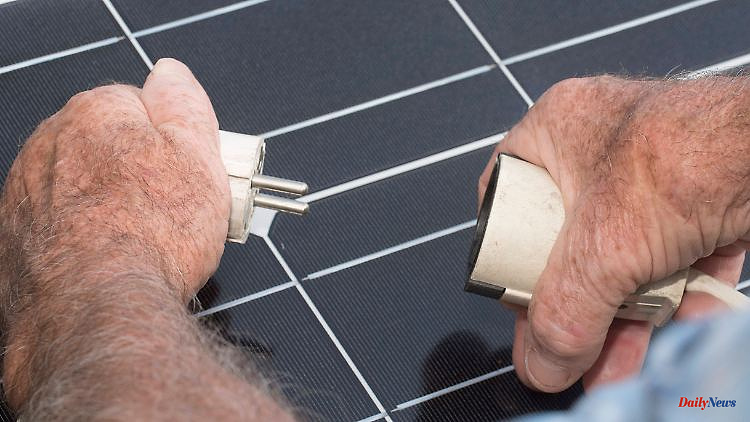Small photovoltaic systems with plugs can also be the first step for tenants to produce their own electricity. You can read here whether it is worth it and what needs to be considered.
In Berlin, tenants can now also apply for a subsidy of 500 euros for a balcony solar system. There are similar funding programs in other cities and federal states. But even without subsidies, the mini systems can be worthwhile - especially in times of rising electricity prices.
Which locations are suitable?
Depending on the design, the small systems can be placed on the balcony, on the terrace or in the garage or mounted on the house facade. A single module is usually smaller than two square meters and weighs less than 30 kilograms. An integrated module inverter converts the generated direct current into alternating current, which can be fed directly into the home network and consumed. The household appliances in their own circuit always use the electricity from the solar device first and then supplement the mains electricity.
The German Society for Solar Energy (DGS) recommends that the solar device "faces towards the unshaded sky". The turbines perform best when oriented to the south. The further north the modules look, the worse the solar yield. To ensure that the modules are at the optimum angle to the sun, they should be inclined between 30 and 45 degrees.
Do the mini systems pay off?
While solar modules on the roof generate several thousand kilowatt hours, the mini PV systems on the balcony only generate a few hundred kilowatt hours. Most balcony solar panels have an output of 200 to 600 watts.
The mini systems can still pay off: the modules have been exempt from VAT since the beginning of the year, and there are inexpensive models for just a few hundred euros. In addition there are - possibly - costs for the installation by a craft business.
The balcony systems can reduce a household's electricity costs by 50 to 200 euros per year - this depends, among other things, on the solar radiation and consumption habits: solar power is generated during the day and then has to be used. The purchase will pay for itself in several years. The cost-effectiveness can be estimated using the plug-in solar simulator from the HTW Berlin.
How are the modules connected?
If you buy a ready-to-use solar system, you can connect it directly to your home's power grid via the socket. According to the manufacturers, this can usually be done safely with small systems via the normal socket outlet with earthing contact. However, some network operators still require the installation of a safe-to-touch socket.
With an output of more than 600 watts, the installation should be carried out by a qualified electrician. She should also check whether the lines in the house have enough capacity for the feed-in. The fuse may need to be replaced. Caution is called for, especially in old buildings.
The network of consumer advice centers emphasizes that plug-in solar devices are "very safe". According to this, 190,000 systems were in operation in Germany by the end of 2021 - so far no case of property damage or injured people has been reported.
What else do system operators have to do?
Tenants must obtain the landlord's approval - for example, if they need to drill holes in the facade or make changes to the appearance of the facade. As a rule, a community of owners must also consent; since 2020, a majority permit is sufficient, unanimity is not necessary.
Anyone who connects a solar system to the grid must report it to the grid operator and the Federal Network Agency. The website of the German Electrical Engineering Association (VDE) explains how to do this.
Due to the plug-in solar device, it could happen that conventional electricity meters with mechanical turntables run backwards, because these meters are not equipped with a backstop. Therefore, in this case, the network operator exchanges the conventional meter for a modern electronic meter, as the consumer centers explain. This is free of charge - however, the measurement costs can increase.
Is feeding into the public grid worth it?
The mini systems can also benefit from the EEG feed-in tariff and earn money with it. "However, the amount of electricity fed in and thus remunerated is likely to be very small," restricts the Electrical Engineering Association VDE. The bureaucratic effort is usually not worth it. "First and foremost, self-consumption should be covered." If you don't want to give away the excess self-generated electricity, you can buy a battery storage system.












